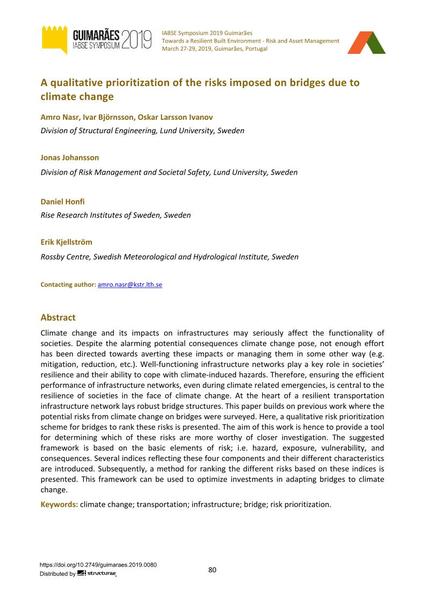A qualitative prioritization of the risks imposed on bridges due to climate change

|
|
|||||||||||
Bibliographic Details
| Author(s): |
Amro Nasr
(Division of Structural Engineering, Lund University, Sweden)
Ivar Björnsson Oskar Larsson Ivanov (Division of Structural Engineering, Lund University, Sweden) Jonas Johansson (Division of Risk Management and Societal Safety, Lund University, Sweden) Erik Kjellström (Rossby Centre, Swedish Meteorological and Hydrological Institute, Sweden) |
||||
|---|---|---|---|---|---|
| Medium: | conference paper | ||||
| Language(s): | English | ||||
| Conference: | IABSE Symposium: Towards a Resilient Built Environment Risk and Asset Management, Guimarães, Portugal, 27-29 March 2019 | ||||
| Published in: | IABSE Symposium Guimarães 2019 | ||||
|
|||||
| Page(s): | 80-87 | ||||
| Total no. of pages: | 8 | ||||
| DOI: | 10.2749/guimaraes.2019.0080 | ||||
| Abstract: |
Climate change and its impacts on infrastructures may seriously affect the functionality of societies. Despite the alarming potential consequences climate change pose, not enough effort has been directed towards averting these impacts or managing them in some other way (e.g. mitigation, reduction, etc.). Well-functioning infrastructure networks play a key role in societies’ resilience and their ability to cope with climate-induced hazards. Therefore, ensuring the efficient performance of infrastructure networks, even during climate related emergencies, is central to the resilience of societies in the face of climate change. At the heart of a resilient transportation infrastructure network lays robust bridge structures. This paper builds on previous work where the potential risks from climate change on bridges were surveyed. Here, a qualitative risk prioritization scheme for bridges to rank these risks is presented. The aim of this work is hence to provide a tool for determining which of these risks are more worthy of closer investigation. The suggested framework is based on the basic elements of risk; i.e. hazard, exposure, vulnerability, and consequences. Several indices reflecting these four components and their different characteristics are introduced. Subsequently, a method for ranking the different risks based on these indices is presented. This framework can be used to optimize investments in adapting bridges to climate change. |
||||
| Keywords: |
bridge transportation infrastructure climate change risk prioritization
|
||||
